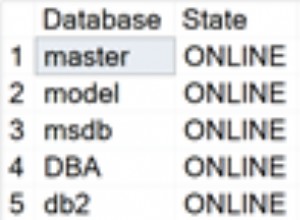Odkryłem, że rzeczy, które SQL Server daje do wykonania rozmytego dopasowania, są dość niezgrabne. Miałem naprawdę szczęście z moimi własnymi funkcjami CLR używającymi algorytmu odległości Levenshteina i ważenia. Korzystając z tego algorytmu, stworzyłem następnie UDF o nazwie GetSimilarityScore, który pobiera dwa ciągi i zwraca wynik między 0,0 a 1,0. Im bliżej 1.0 jest mecz, tym lepiej. Następnie wykonaj zapytanie z progiem>=0,8 lub podobnym, aby uzyskać najbardziej prawdopodobne dopasowania. Coś takiego:
if object_id('tempdb..#similar') is not null drop table #similar
select a.id, (
select top 1 x.id
from MyTable x
where x.id <> a.id
order by dbo.GetSimilarityScore(a.MyField, x.MyField) desc
) as MostSimilarId
into #similar
from MyTable a
select *, dbo.GetSimilarityScore(a.MyField, c.MyField)
from MyTable a
join #similar b on a.id = b.id
join MyTable c on b.MostSimilarId = c.id
Po prostu nie rób tego z naprawdę dużymi stołami. To powolny proces.
Oto CLR UDF:
''' <summary>
''' Compute the distance between two strings.
''' </summary>
''' <param name="s1">The first of the two strings.</param>
''' <param name="s2">The second of the two strings.</param>
''' <returns>The Levenshtein cost.</returns>
<Microsoft.SqlServer.Server.SqlFunction()> _
Public Shared Function ComputeLevenstheinDistance(ByVal string1 As SqlString, ByVal string2 As SqlString) As SqlInt32
If string1.IsNull OrElse string2.IsNull Then Return SqlInt32.Null
Dim s1 As String = string1.Value
Dim s2 As String = string2.Value
Dim n As Integer = s1.Length
Dim m As Integer = s2.Length
Dim d As Integer(,) = New Integer(n, m) {}
' Step 1
If n = 0 Then Return m
If m = 0 Then Return n
' Step 2
For i As Integer = 0 To n
d(i, 0) = i
Next
For j As Integer = 0 To m
d(0, j) = j
Next
' Step 3
For i As Integer = 1 To n
'Step 4
For j As Integer = 1 To m
' Step 5
Dim cost As Integer = If((s2(j - 1) = s1(i - 1)), 0, 1)
' Step 6
d(i, j) = Math.Min(Math.Min(d(i - 1, j) + 1, d(i, j - 1) + 1), d(i - 1, j - 1) + cost)
Next
Next
' Step 7
Return d(n, m)
End Function
''' <summary>
''' Returns a score between 0.0-1.0 indicating how closely two strings match. 1.0 is a 100%
''' T-SQL equality match, and the score goes down from there towards 0.0 for less similar strings.
''' </summary>
<Microsoft.SqlServer.Server.SqlFunction()> _
Public Shared Function GetSimilarityScore(string1 As SqlString, string2 As SqlString) As SqlDouble
If string1.IsNull OrElse string2.IsNull Then Return SqlInt32.Null
Dim s1 As String = string1.Value.ToUpper().TrimEnd(" "c)
Dim s2 As String = string2.Value.ToUpper().TrimEnd(" "c)
If s1 = s2 Then Return 1.0F ' At this point, T-SQL would consider them the same, so I will too
Dim flatLevScore As Double = InternalGetSimilarityScore(s1, s2)
Dim letterS1 As String = GetLetterSimilarityString(s1)
Dim letterS2 As String = GetLetterSimilarityString(s2)
Dim letterScore As Double = InternalGetSimilarityScore(letterS1, letterS2)
'Dim wordS1 As String = GetWordSimilarityString(s1)
'Dim wordS2 As String = GetWordSimilarityString(s2)
'Dim wordScore As Double = InternalGetSimilarityScore(wordS1, wordS2)
If flatLevScore = 1.0F AndAlso letterScore = 1.0F Then Return 1.0F
If flatLevScore = 0.0F AndAlso letterScore = 0.0F Then Return 0.0F
' Return weighted result
Return (flatLevScore * 0.2F) + (letterScore * 0.8F)
End Function
Private Shared Function InternalGetSimilarityScore(s1 As String, s2 As String) As Double
Dim dist As SqlInt32 = ComputeLevenstheinDistance(s1, s2)
Dim maxLen As Integer = If(s1.Length > s2.Length, s1.Length, s2.Length)
If maxLen = 0 Then Return 1.0F
Return 1.0F - Convert.ToDouble(dist.Value) / Convert.ToDouble(maxLen)
End Function
''' <summary>
''' Sorts all the alpha numeric characters in the string in alphabetical order
''' and removes everything else.
''' </summary>
Private Shared Function GetLetterSimilarityString(s1 As String) As String
Dim allChars = If(s1, "").ToUpper().ToCharArray()
Array.Sort(allChars)
Dim result As New StringBuilder()
For Each ch As Char In allChars
If Char.IsLetterOrDigit(ch) Then
result.Append(ch)
End If
Next
Return result.ToString()
End Function
''' <summary>
''' Removes all non-alpha numeric characters and then sorts
''' the words in alphabetical order.
''' </summary>
Private Shared Function GetWordSimilarityString(s1 As String) As String
Dim words As New List(Of String)()
Dim curWord As StringBuilder = Nothing
For Each ch As Char In If(s1, "").ToUpper()
If Char.IsLetterOrDigit(ch) Then
If curWord Is Nothing Then
curWord = New StringBuilder()
End If
curWord.Append(ch)
Else
If curWord IsNot Nothing Then
words.Add(curWord.ToString())
curWord = Nothing
End If
End If
Next
If curWord IsNot Nothing Then
words.Add(curWord.ToString())
End If
words.Sort(StringComparer.OrdinalIgnoreCase)
Return String.Join(" ", words.ToArray())
End Function




